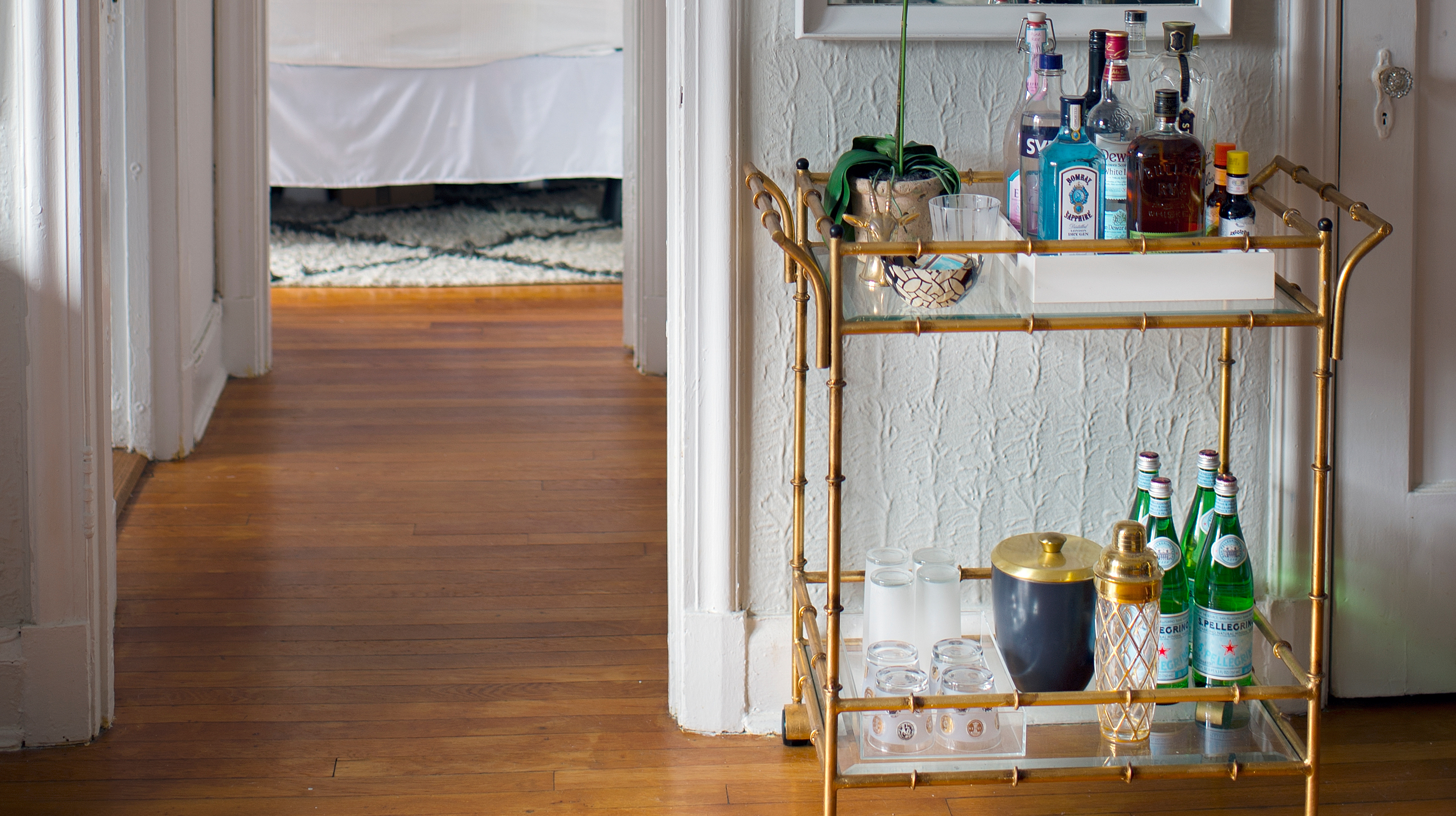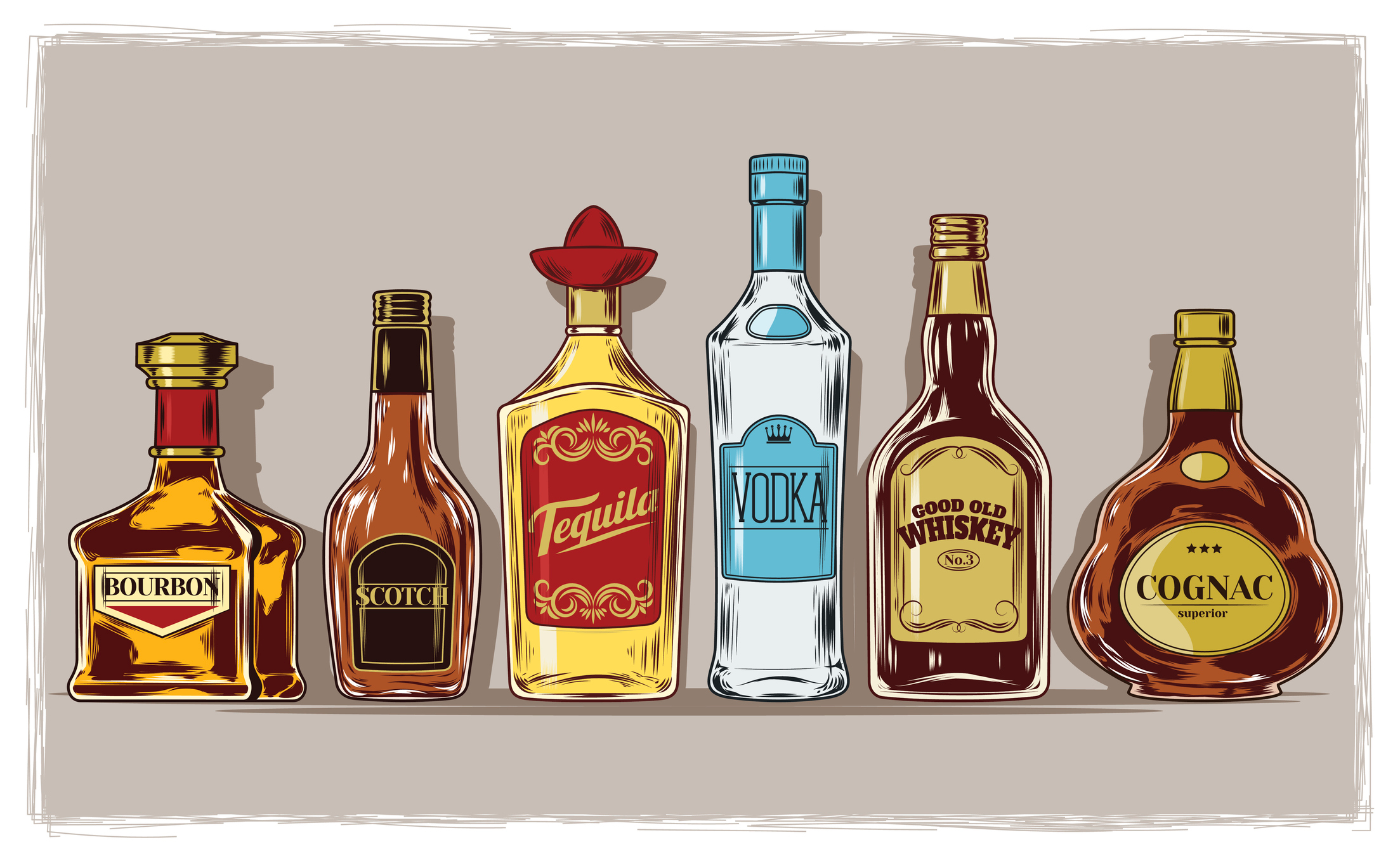How To Build Your Bar Cart (Slowly, Strategically, Whilst Sloshed)
We may receive a commission on purchases made from links.
A bar cart is one of those pieces of furniture that makes a person feel very grown-up—at least, it made me feel very grown-up, when I finally got one. I put all my booze on the top shelf, placed the box containing my coupe glasses on the bottom shelf (I'd take them out later), and called it a day. Then it sat there, a dusty old glorified whiskey shelf, for months.
My approach, if you can even call it that, was all wrong. It's taken me a year to course-correct. Some of that is linked to my personal finances—if you're in the happy position to drop a fat wad of cash on a lot of nice liquor all at once, you can speed up the process considerably—but it's not a process that has to be rushed. Think of a bar cart (or a sideboard, or a stout bookshelf, or whatever you're using) as a place to keep a collection, and collections are built over time.
It's also a piece of furniture that's designed to be used, not merely filled. To be useful, a bar cart needs to feel a little bit like a pantry for fancy booze. There are things you'll almost always want in a pantry—flour, sugar, salt, pepper, baking soda, rice, dried beans, paprika, cinnamon, what have you—so that when you need them, they'll be ready at hand. Beyond that, there are tools (in our kitchen metaphor, the measuring cups, wooden spoons, spatulas, and mixing bowls) you'll need for your recipes, and you'll want them all arranged so that you can grab what you need easily.
And while it may sound frivolous, this might be the most important requirement of your bar cart: It needs to be a little piece of your home that you really like, or you'll never use it. It needs to be accessible, pretty, and not so formidable that you'll never dare make a cocktail, or it'll end up a dusty old glorified whiskey shelf.
Here are some basic principles to start with, followed by a checklist of shorts. When you've got yourself situated and are pouring a nice Sidecar, think fondly of me. That is all I ask.
1. Stocking your pantry = starting your collection
There are two general principles here that would seem to be in direct opposition to each other. The first: Don't buy anything you don't want to drink. Life is too short to spend money on stuff you don't like. The second: Have at least one decent bottle of the five big spirits. That means you'll want gin, vodka, rum, whiskey, and tequila.
Doesn't make sense, right? That's the kind of contradiction that could swallow an anxious, indecisive person like me whole. I reconciled these by locking on to this idea of both stocking a pantry and starting a collection. I'm not a huge rum-drinker—bad choices in college—so I started with one rum that I really love; I'll eventually add a white rum for those who are really craving a rum and coke. Those main five spirits get used a lot; if you want to make cocktails for guests (or just make your way through a classic cocktail book—more on those later), you'll want to have them all.
That said, if you never have people over and totally hate gin, don't buy gin. Well, go to a nice bar and try a Negroni first, and if you hate that, then don't buy gin.
2. Have a top shelf and a bottom shelf (even if you only have one shelf)
This notion goes hand in hand with the last.
Two of my jobs—this one, and my shadowy life as a fancy whiskey shopgirl—involve fancy whiskey, and as a result, I buy a lot of fancy whiskey. I'd get a bottle of, say, J. Riddle Peated Bourbon, and then two weeks later, it would be gone. So it goes when two people with poor impulse control share a roof, a bar cart, and a love of whiskey.
I've mostly solved that issue by making sure I've always got an "everyday" bottle of whiskey to hand. My friend Wally Anderson, the general manager of Rogers Park Social in Chicago, put me on this particular track. He said I should think like a bartender in a proper bar. I was making good progress on my top shelf, but I needed to think about my well.
That's not to say that my "well" spirits aren't also good. They are. But having a more reasonable whiskey to hand—at the moment, it's Johnny Drum—makes it more likely that my J. Riddle, Laws, Brenne, and J. Henry will last. If you don't ever drink tequila, but want a bottle for your pantry, there's no need to think about the top shelf. If you, like me, love whiskey, you can have a "well" whiskey and then four or five top-shelf bottles. They're your Sunday clothes bottles, or your special occasion bottles, or hell, just your sipping bottles. The "well" bottle is for everyday use.
3. Don’t overpack or underfill
There's no standard size for a bar cart. If yours is adorable and small, shop for the size, not any list, and prioritize what you like. But even if you've got a fairly big piece of furniture, make sure you don't crowd your spirits—there's no need to keep every bottle you own out at once. Keep new bottles elsewhere until you finish an old one. Tuck away liqueurs you might only use in a particular season. Hell, keep the vodka in the freezer, if that's your thing.
In short, if your bar cart is too crowded, it becomes less useful and and less appealing all at once. That's dusty old whiskey shelf territory.
That said, a mostly empty bar cart is also less useful and less appealing—and if you have a cat, a mostly empty bar cart is a recipe for disaster. I speak from experience. So if you're still building your collection, fill some space with glassware (a good idea in general), growlers, cocktail books, an ice bucket, a fruit bowl, knickknacks, wine, whatever you like.
4. Pace yourself, and shop for cocktails you like
I would never suggest that every bar cart needs a bottle of creme de violette. It's not a liqueur that gets used in countless classic cocktails. Mine includes it because I love Aviations, so I shopped for what I like. Not insanely practical, but very useful to me, and having it makes it far more likely that I'll turn to my cart.
But I didn't buy all my ingredients for that cocktail at once. The gin and cocktail cherries came first. And while I also love Negronis, I don't have a bottle of Campari at the moment. I do have fernet, because I wanted a digestif in a pretty bottle. I have apple brandy, but not brandy; I have an alpine liqueur I was curious about, but no white rum. And that's all fine.
The point is not to be able to make any cocktail at any time. The point is to be able to make yourself something you love, to try something new, and to offer a drink to a friend with a reasonable amount of confidence that you'll be able to fulfill their request. Godspeed.
Your bar-cart checklist
Add and remove things as you see fit. If some of these things get stored elsewhere, it's totally cool. This list does not include glassware—you know best what you'll actually use, but I'm a big supporter of coupes and lowball glasses as versatile alcohol vessels. Regardless, dust them often.
Oh, and keep some lemons and limes on hand. You're going to need a lot of lemons and limes. You might also consider ginger beer, syrups, tonic, soda water, sparkling wine, shrubs.
The basics (your pantry/well)
Base spirits
- Gin: London dry or botanical, based on your personal preference
- Vodka: not flavored, suitable for mixing (don't spend like crazy here)
- Rum: white or spiced, based on personal preference
- Tequila: blanco, suitable for mixing
- Whiskey: bourbon or rye, personal preference. If you're a whiskey nerd, feel free to go top-shelf (or top-shelf adjacent) here. Just don't waste it by mixing it with Coke.
- Triple sec
- Sweet vermouth
- Dry vermouth (after opening, you'll need to keep vermouth in the fridge)
- Set of cocktail shaker tins
- Bar spoon, ideally the spiral kind
- Strainer of some sort (preferably Hawthorne)
- Jigger
- Bar cherries (Luxardo, if you possibly can)
- Bitters (old-fashioned, Angostura, etc.)
Liqueurs
Equipment/Odds and ends
Build from here as you like.
Intermediate-level bar-carting (your top shelf)
Base spirits
This is the sipping/variation level.
- Gin: Whichever you didn't get above (London dry gin or botanical), or a barrel-aged gin (my super special favorite)
- Vodka: If you really want a flavored vodka, then go for it, but I'd suggest a nice vodka with a lot of character (they exist)
- Mezcal (or an Añejo or Reposado)
- Whiskey: Scotch, or whichever you didn't pick above if you're not a scotch drinker
- Rum: whatever you didn't choose above, or your personal favorite with some age on it
- Brandy
- Amaretto
- Maraschino
- Amaro (fernet, Campari, etc.)
- Coffee liqueur
- Another floral/fruit liqueur (creme de violette, creme de cassis, etc.)
- A bottle for simple syrup (if you can find a glass-corked wine bottle, just use that; otherwise, just find something you can close up and easily pour into/from)
- A muddler
- A cocktail book (I like Imbibe!, but there are lots of great options)
Liqueurs
Equipment
Advanced-level bar-carting (let’s get weird!)
Base spirits
This is the sipping/variation level.
- Gin: There's so much strange, cool gin. If you haven't already picked a barrel-aged, pick one here.
- Mezcal or Sotol
- Whiskey: Get really fancy here; maybe Japanese!
- Cognac or Armangac
- Absinthe
- Something else cool: Cachaça! Genever! Shochu! Explore and find something you can't wait to let other people try
- Glass rimmer
- Swizzle sticks
- Fancy matches
- Mixing pitcher/glass (they're pretty and useful)
- Channel knife (great for garnishes)
- Weird bitters. I love weird bitters. I'm a particular fan of Dashfire's bitters.
Liqueurs
Go nuts. Liqueurs are really fun to explore.
Equipment and odds and ends
In conclusion
I know that's a lot. Again, pace yourself! Pick things one at a time, make yourself use them, and you will feel so fancy. Your bar cart may soon turn into your favorite piece of furniture.

